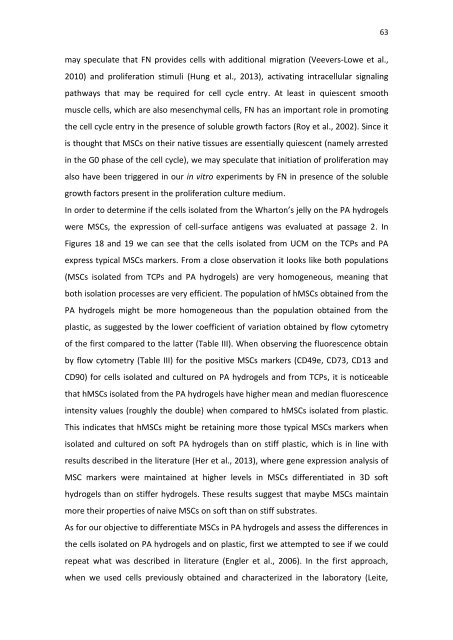DEPARTAMENTO DE CIÊNCIAS DA VIDA ... - Estudo Geral
DEPARTAMENTO DE CIÊNCIAS DA VIDA ... - Estudo Geral
DEPARTAMENTO DE CIÊNCIAS DA VIDA ... - Estudo Geral
You also want an ePaper? Increase the reach of your titles
YUMPU automatically turns print PDFs into web optimized ePapers that Google loves.
63<br />
may speculate that FN provides cells with additional migration (Veevers-Lowe et al.,<br />
2010) and proliferation stimuli (Hung et al., 2013), activating intracellular signaling<br />
pathways that may be required for cell cycle entry. At least in quiescent smooth<br />
muscle cells, which are also mesenchymal cells, FN has an important role in promoting<br />
the cell cycle entry in the presence of soluble growth factors (Roy et al., 2002). Since it<br />
is thought that MSCs on their native tissues are essentially quiescent (namely arrested<br />
in the G0 phase of the cell cycle), we may speculate that initiation of proliferation may<br />
also have been triggered in our in vitro experiments by FN in presence of the soluble<br />
growth factors present in the proliferation culture medium.<br />
In order to determine if the cells isolated from the Wharton’s jelly on the PA hydrogels<br />
were MSCs, the expression of cell-surface antigens was evaluated at passage 2. In<br />
Figures 18 and 19 we can see that the cells isolated from UCM on the TCPs and PA<br />
express typical MSCs markers. From a close observation it looks like both populations<br />
(MSCs isolated from TCPs and PA hydrogels) are very homogeneous, meaning that<br />
both isolation processes are very efficient. The population of hMSCs obtained from the<br />
PA hydrogels might be more homogeneous than the population obtained from the<br />
plastic, as suggested by the lower coefficient of variation obtained by flow cytometry<br />
of the first compared to the latter (Table III). When observing the fluorescence obtain<br />
by flow cytometry (Table III) for the positive MSCs markers (CD49e, CD73, CD13 and<br />
CD90) for cells isolated and cultured on PA hydrogels and from TCPs, it is noticeable<br />
that hMSCs isolated from the PA hydrogels have higher mean and median fluorescence<br />
intensity values (roughly the double) when compared to hMSCs isolated from plastic.<br />
This indicates that hMSCs might be retaining more those typical MSCs markers when<br />
isolated and cultured on soft PA hydrogels than on stiff plastic, which is in line with<br />
results described in the literature (Her et al., 2013), where gene expression analysis of<br />
MSC markers were maintained at higher levels in MSCs differentiated in 3D soft<br />
hydrogels than on stiffer hydrogels. These results suggest that maybe MSCs maintain<br />
more their properties of naive MSCs on soft than on stiff substrates.<br />
As for our objective to differentiate MSCs in PA hydrogels and assess the differences in<br />
the cells isolated on PA hydrogels and on plastic, first we attempted to see if we could<br />
repeat what was described in literature (Engler et al., 2006). In the first approach,<br />
when we used cells previously obtained and characterized in the laboratory (Leite,
















